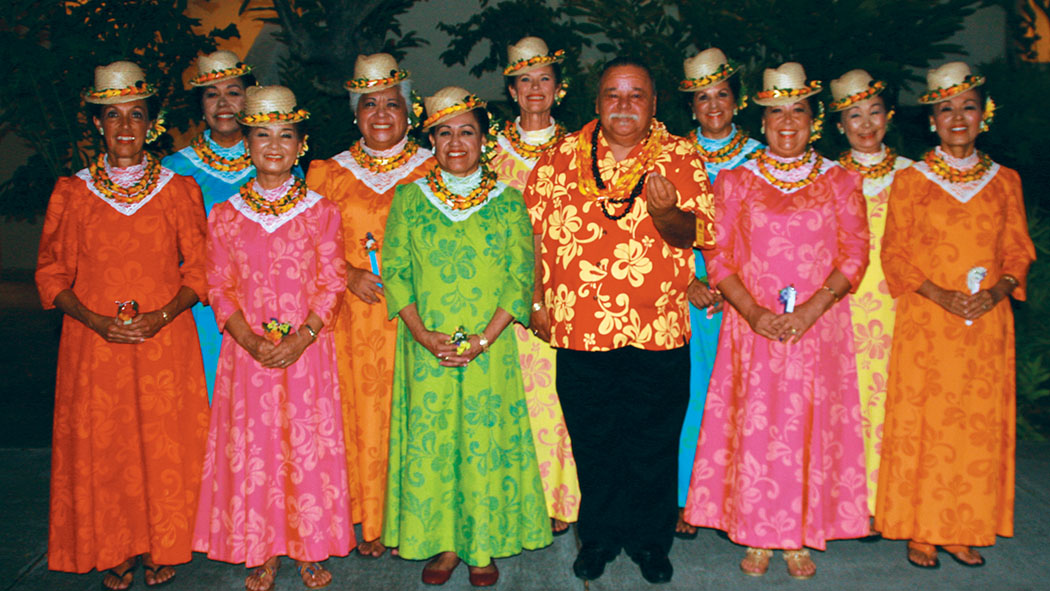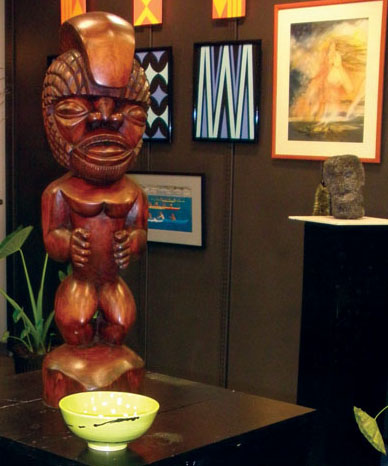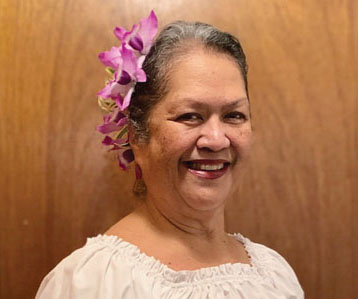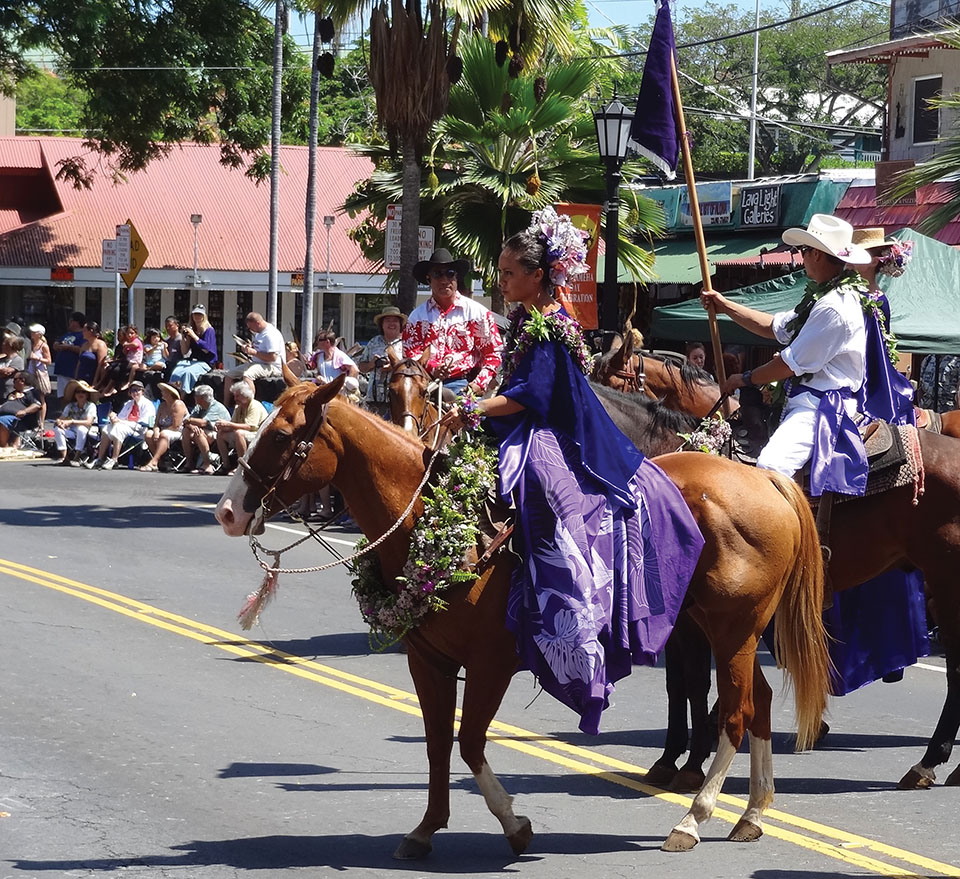
Wahine Holo Lio (Women Riding Horses)

By Denise Laitinen
They are easily one of the most popular parts of any floral parade in Hawai‘i. Sitting regally atop their horses adorned in lei, shimmering colored fabrics draping them from head to toe, the graceful women wave to enchanted onlookers as they ride along the parade route.
To be sure, pā‘ū riders are the highlight of any Hawaiian parade. Yet few people realize just how much time, energy, and work goes into being a pā‘ū rider and participating in a parade. The pā‘ū queen and princesses must excel at horsemanship, gather all the flowers and materials needed for their lei to create intricate headpieces and lei for themselves and their horses, as well as design costumes for themselves and their entire riding unit.
History of Pā‘ū Riders
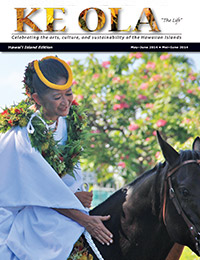
Horses were first imported to Hawai‘i in 1803 when Richard J. Cleveland presented two horses to King Kamehameha I on Maui after dropping off a mare and a foal on Hawai‘i Island. In the years that followed, Hawaiian women became accomplished equestrians.
“Hawaiian women in the 1800s were beautiful riders. They rode bareback,” says Barbara Nobriga of Mahealani Ranch in Kona, one of our leading experts on pā‘ū riding.
Being accomplished equestrians, riding sidesaddle seemed silly to Hawai‘i horsewomen who frequently had to travel through rugged terrain, including streams, mud, and lava fields.
To protect their clothes when traveling to visit someone, they covered themselves with a long culottes-style pā‘ū skirt. Pā‘ū skirts are made of 9–12 yards of fabric, wrapped in a way so as to flow past the stirrups. In the 1800s, pā‘ū were made of calico or gingham and were fastened to the rider’s waist and ankles with rope. Kukui nuts have long since replaced rope to ensure the skirts are securely wrapped around the rider. Using anywhere from 4–8 kukui nuts, the fabric is carefully pleated and twisted with the kukui nut tucked into the waistband of the rider.
When floral parades were introduced to Hawai‘i starting in the early 1900s, pā‘ū riders started participating as groups. Over time, their costumes became more elaborate as practical calico skirts gave way to satin fabrics and elaborate lei.
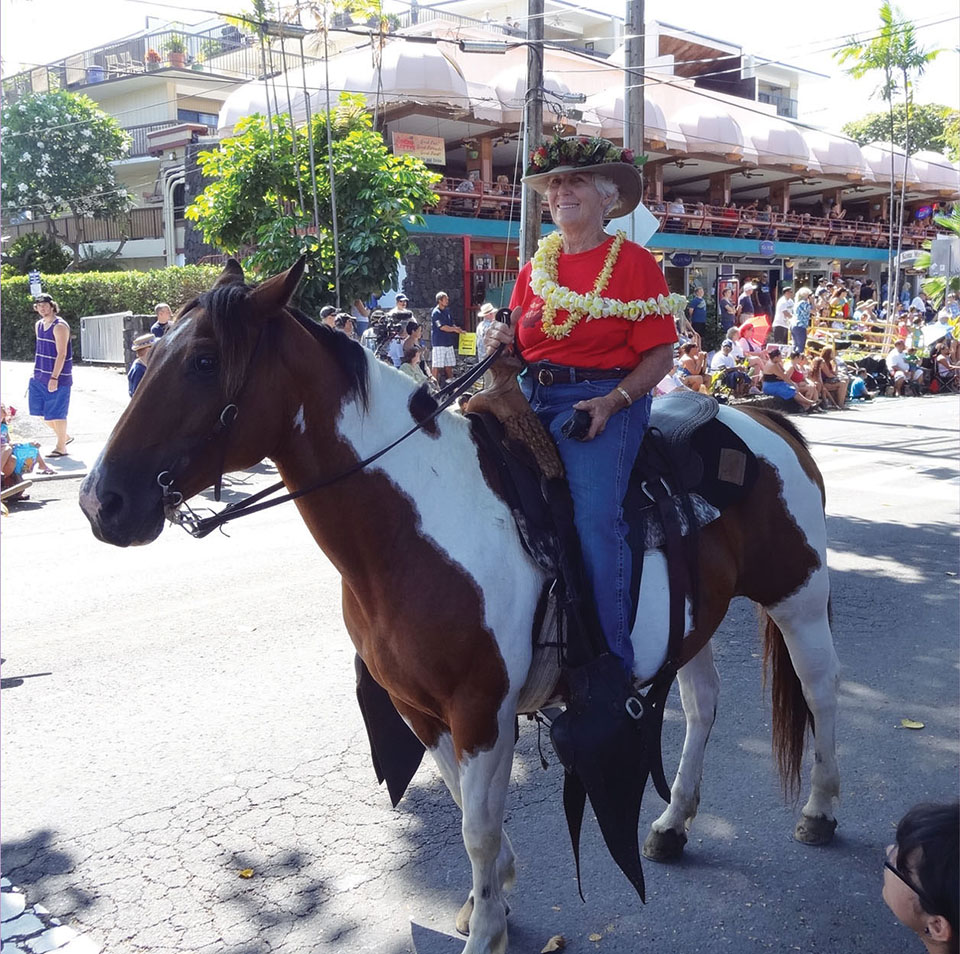
A full pā‘ū contingent in a parade includes the pā‘ū queen and her unit and eight princesses, each leading their own unit representing a different Hawaiian island. Each unit has a minimum of six members including pages, outriders, attendants, and even a pooper-scooper. Each princess and the members of her unit wear the colors and flowers associated with the island they represent.
For instance, Hawai‘i Island’s official color is red and is represented by the red lehua flower from the ‘ōhi‘a tree. The color pink and the lokelani flower, the pink Damask rose, represent Maui, while Kaho‘olawe’s official color is gray and their flower is hinahina, a native beach heliotrope.
Pā‘ū riders representing Moloka‘i wear green, which symbolizes kukui, the blossom of the candlenut tree. Riders representing Lāna‘i wear orange and lei made of the kauna‘oa flower, a native dodder.
O‘ahu’s color is golden yellow, signified by the ‘ilima flower. Kaua‘i’s official color is purple, symbolized by the mokihana berry, and Ni‘ihau’s official color is white for the pūpū, or tiny seashells, found on the island’s shores.
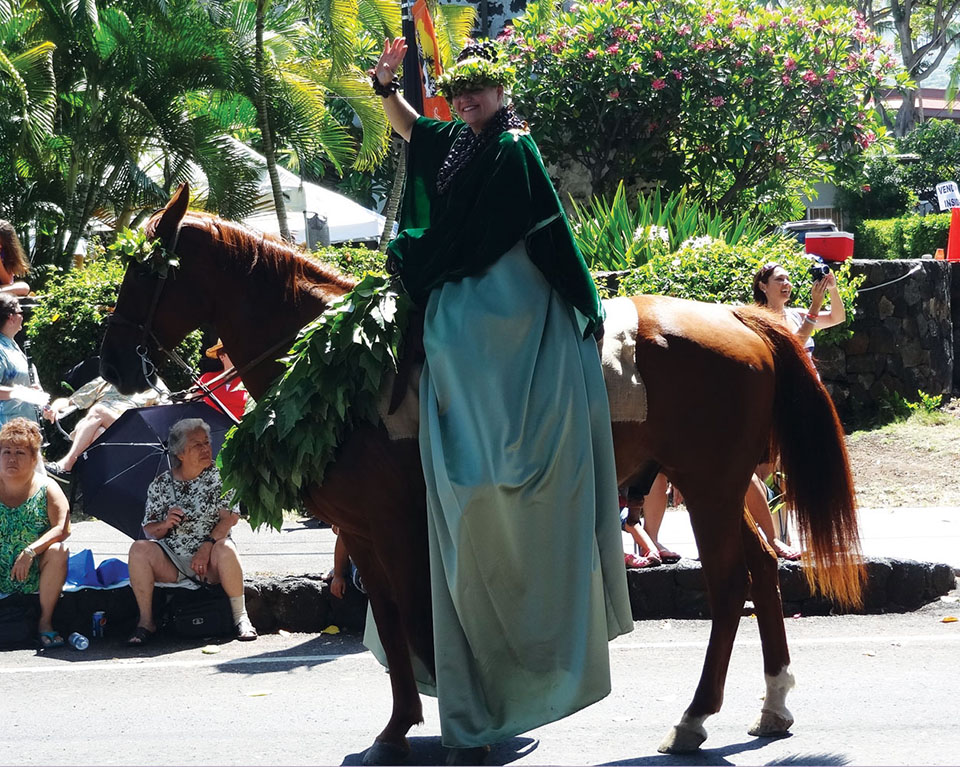
And while the princesses must wear the color of the island they represent, the Queen, says Barbara, has the option of wearing attire based on her own ‘āina.
Sometimes the pā‘ū queens choose to wear white, but Barbara points out that in 2012 well-known horsewoman DeeDee Bertelmann, who was the Pā‘ū Queen for the Kailua-Kona Kamehameha Day parade, wore black. Barbara, the longtime chairperson of the parade, recalls that DeeDee chose the color to represent the lava of her native Pu‘uanahulu and also included lehua blossoms and kukui nuts in her adornments.
Pā‘ū riding units can be seen in King Kamehameha Day parades around the island in June (see sidebar for upcoming parade information), the Merrie Monarch parade held every April in Hilo, as well as the annual Paniolo Parade in Waimea every October, among others.
Barbara says that there are several groups, usually extended families that ride pā‘ū on-island. However, each floral parade on-island is run separately, so it’s up to each parade’s steering committee to select pā‘ū riders for their respective parade. And the riders don’t always represent the same island says Barbara. Units change from parade to parade, as do the princesses and pā‘ū queen.
Barbara herself first rode in pā‘ū in a Hilo parade more than 60 years ago when she was a page for a Hawai‘i Island unit back in 1953. The page carries the banner in front of the princess.
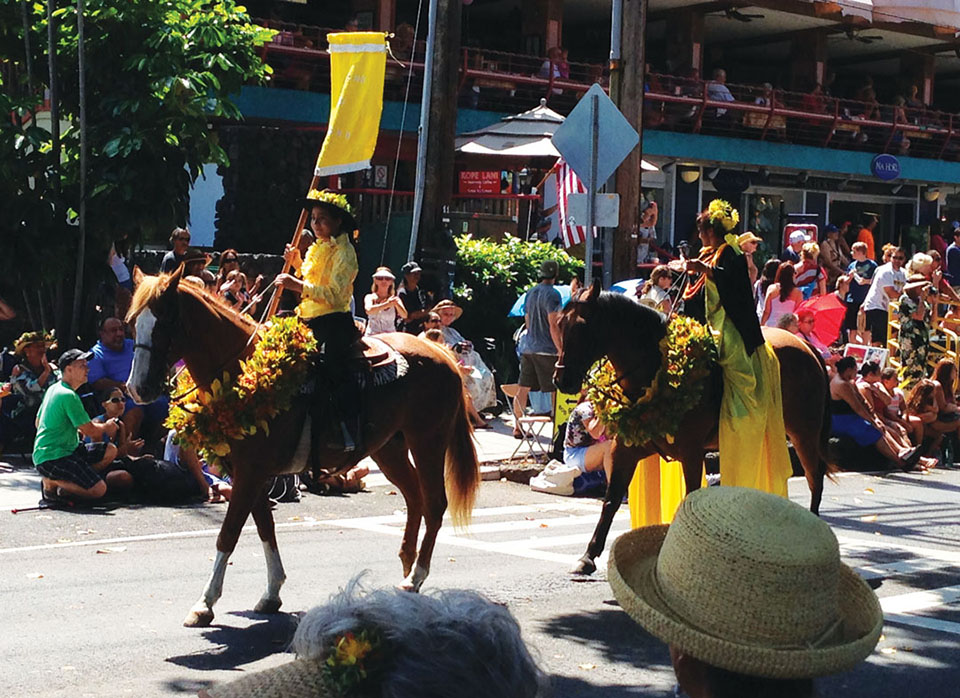
She explains, “There weren’t a lot of parades between 1953 and 1967. It really got started in 1967, and there’s been a [King Kamehameha Day] parade every year since then.”
According to Barbara, the level of pā‘ū riding has fluctuated over the years.
“The quality of riders has been improving because there has been a lot more female participation in rodeos,” says Barbara. “It used to be [pā‘ū riders] were a paniolo’s wife or a ranch manager’s wife or daughter.
“Now you have women competing in rodeos, and they are accomplished riders in their own right. It’s made a huge difference in the quality of riders we’re able to call on now,” adds Barbara.
Barbara knows what she is talking about when it comes to accomplished riders. She is one half of the only mother-daughter duo inducted into to the Paniolo Hall of Fame. Her mother, Kapua Heuer was inducted in 2000 and Barbara was inducted in 2004. A fourth generation rancher related to Ikua Purdy, Hawai‘i’s most famous cowboy, Barbara has received numerous awards over the years for perpetuating paniolo culture in Hawai‘i. (See Barbaraʻs story in the May-June 2013 issue of Ke Ola.)
For the past several years Barbara has served as the chairperson for the King Kamehameha Day parade in Kailua-Kona, as well as the committee head for the parade’s pā‘ū units. In that capacity, it’s up to Barbara to select the pā‘ū queen and princesses for the annual parade.
Barbara says she calls around and invites people to participate as the pā‘ū queen and princesses about six months before the parade.
“I’ve got a good nucleus going right now. We try to bring in new riders every year, and we have our standby units that I can call at the last minute because I know someone may need to back out of the parade.”
Barbara has also learned to be prepared for any circumstance that might arise.
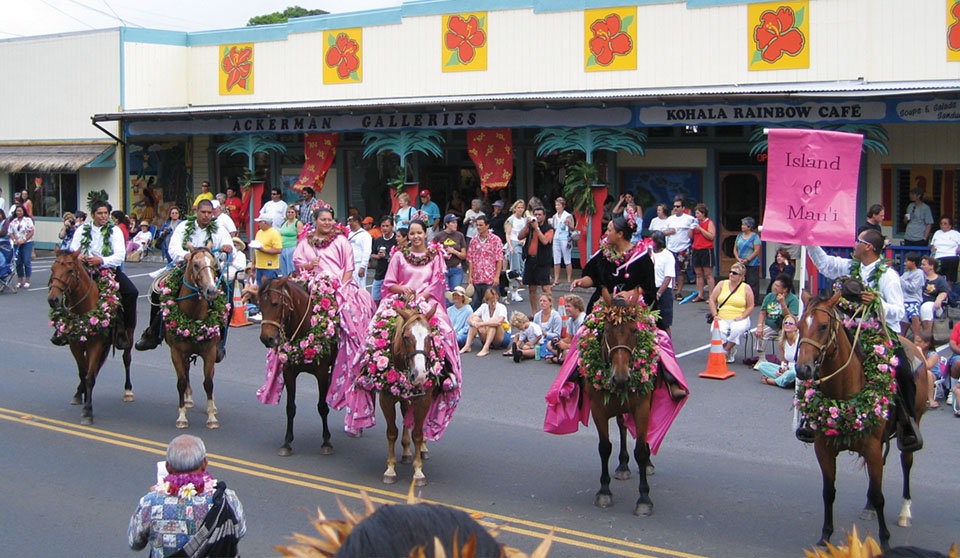
“One year we had an accident,” says Barbara. The horse being ridden by the princess representing Moloka‘i reared up and landed on the pā‘ū rider, breaking her pelvis.
With the parade soon to commence, Barbara had to act quickly. “My mother was standing there, and I turned to her and told her to get dressed. My mother went through the parade and the princess went to the hospital.”
Because the pā‘ū princesses are riding horses in crowded public areas, they must possess exceptional riding skills, a key point for Barbara.
“Lots of people want to ride [in the parade],” says Barbara “Finding a rider is easy. Finding a rider that knows how to ride is the hard part.”
About two months before the parade, Barbara and other leading equestrians and historians, such as DeeDee Bertelmann and Hannah Springer, hold a public workshop to address the roles and responsibilities of the pā‘ū rider. During the workshop, the queen and princesses are taught the finer points of lei making for horse and rider, the wrapping of the pā‘ū (skirt), and riding protocol.
For Barbara, it’s important that princesses and queen know firsthand how to wrap their own pā‘ū and use the appropriate florals.
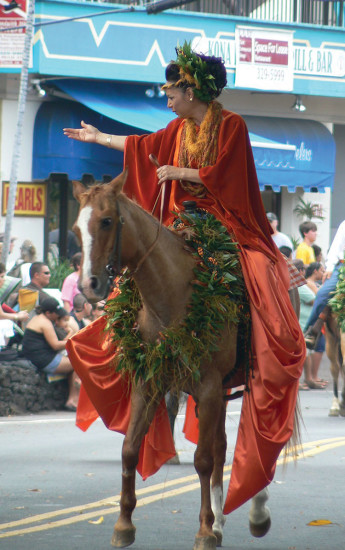
“If you hire planners to create your parade unit, you will never know how to do it,” says Barbara. She continues, “If someone does all the work for you how will you perpetuate the knowledge for the next generation? The riders need to know how to wrap their own pā‘ū, saddle their own horse, and incorporate the materials they gather into a lei instead of hiring someone to do it. Then you have learned something.”
Barbara sees the pā‘ū units as a way to educate people about the flowers and fauna of the state of Hawai‘i.
“Never mind mainland flowers; stick to the flowers and fauna of the island you are representing.”
Noting that Hawai‘i Island’s official pua (flower) is the red lehua of the ‘ōhi‘a tree, Barbara adds, “We don’t want to see red carnations and anthuriums in your lei.”
“If you continue to use flowers that were brought in, you will perpetuate the idea that it’s ok to use whatever flower is available,” says Barbara. “You’ll never know what flowers are native to your island.”
Using locally grown flowers doesn’t mean a complicated lei, however. Barbara says simplicity is key.
“Simplicity is elegance.”
And the pā‘ū riders that grace Kona’s King Kamehameha Day parade are elegant indeed. ❖
If interested in a workshop on pā‘ū contact Barbara Nobriga: 808.322.9944
Contact writer Denise Laitinen: wahineokekai@yahoo.com
